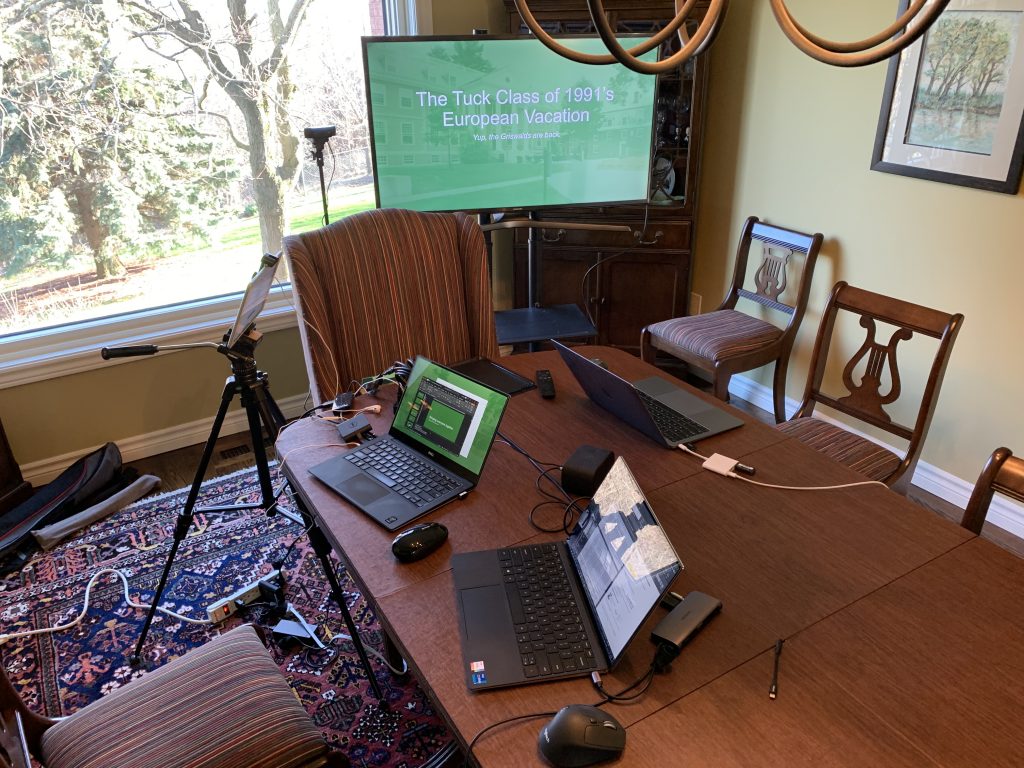This article shares one of the lessons I learned when planning and running a hybrid class reunion event in May 2022. Read the introduction and see the other lessons in this series here.
Lesson
Hybrid meetings are new for most business presenters. We were comfortable with in-person meetings, we got comfortable with presenting in a virtual meeting, and it seems like hybrid would be easy because it combines the two. But it is not as easy as it seems. Practicing the setup will help you be able to focus on the content of your presentation instead of dealing with setup issues in the room.
Before my hybrid reunion event, I conducted a test in our dining room to simulate as much of the equipment setup as possible. Here’s what it looked like on our dining room table.

I used a spare TV as a substitute for the two 70-inch screens that would be in the tent and used a small speaker as a stand-in for the audio system. I have my three laptops, iPad, and webcam connected and running as I planned them for the evening event. I had others connect to a Zoom meeting and act as the remote participants.
This practice session was so valuable. I learned so much from setting up the equipment and from running the practice meeting. I was able to document all the setup, where all the equipment would connect, and how things would run. This made the packing of equipment and the on-site setup so much easier.
When I had to switch from a usual wired internet connection to the cellular hotspot, I also ran mini-tests of some of the setup in our hotel room the day before the event and at the venue the morning of the event. These practice sessions confirmed the changes would work.
Applying this lesson to your meetings
Plan your equipment setup and how the meeting will run
Start by thinking through how you will set up the equipment and how you will run the meeting, including interactive elements. It is valuable to spend time thinking through everything before you start setting up any equipment. It allows you to test elements of the setup individually and resolve any issues. I found this especially valuable for testing the polling service we were using. This also helps you adapt to any last-minute changes in the room because you have already thought things through.
Create and update a setup document
Since hybrid meetings are new to almost all of us, I think it is a good idea to create a document where you detail your equipment and meeting setup. List the pieces of equipment and how they will connect. List what apps or files need to be open. By documenting your plans, it allows you to test the full plan and make changes. Keep this document updated as your meeting environment changes or as you change the equipment or software you are using. I found my plan invaluable for packing to go to the event and for setting everything up on site. This document can then serve as a checklist for future hybrid meetings.
Practice before your first hybrid meeting
Use a meeting room or set up a TV and speakers/phone at home to test out your plan. As much as we think we know how things should work, there is no substitute for practicing. You will learn whether what you planned is actually going to work. It could be as simple as whether the cords are long enough to reach the different pieces of equipment. Run a test meeting and if possible, get a few colleagues to connect in for 10-15 minutes to let you know how it looks and works from their end. Practicing the setup and how the meeting will run can reduce your anxiety and increase the probability that things will run smoothly during the meeting. Update your setup document with what you learned during the practice session.
Wrapup
Since hybrid meetings are new to most of us, you can give yourself the best chance of success by planning and practicing the equipment and meeting setup in advance. Document the setup so in-room setup is smooth and you have a foundation for future hybrid meetings.

Dave Paradi has over twenty-two years of experience delivering customized training workshops to help business professionals improve their presentations. He has written ten books and over 600 articles on the topic of effective presentations and his ideas have appeared in publications around the world. His focus is on helping corporate professionals visually communicate the messages in their data so they don’t overwhelm and confuse executives. Dave is one of fewer than ten people in North America recognized by Microsoft with the Most Valuable Professional Award for his contributions to the Excel, PowerPoint, and Teams communities. His articles and videos on virtual presenting have been viewed over 4.8 million times and liked over 17,000 times on YouTube.
